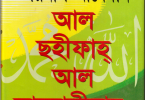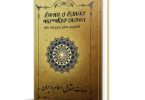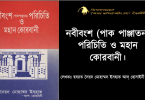 The History of al-Tabari :Tarikh al-Rusul wa’l muluk ‘Annals of the Apostles and Kings’ ‚by Abu Ja’far Muhammad b Jarir al-Tabri (839–923). It is by common consent the most important universal history produced in the world of Islam. Publisher: State University of New York Press. Book Translator: Franz Rosenthal. Year of Publication: 1989.
The History of al-Tabari :Tarikh al-Rusul wa’l muluk ‘Annals of the Apostles and Kings’ ‚by Abu Ja’far Muhammad b Jarir al-Tabri (839–923). It is by common consent the most important universal history produced in the world of Islam. Publisher: State University of New York Press. Book Translator: Franz Rosenthal. Year of Publication: 1989.
◉ History of al-Tabari Vol. 1_pdf
General Introduction and From the Creation to the Flood:
Volume 1 of the thirty-eight volume translation of Tabari’s great History begins with the creation of the world and ends with the time of Noah and the Flood.It not only brings a vast amount of speculation about the early history of mankind into sharp Muslim focus, but it also synchronizes ancient Iranian ideas about the prehistory of mankind with those inspired by the Qur’an and the Bible.The volume is thus an excellent guide to the cosmological views of many of Tabari’s contemporaries.The translator, Franz Rosenthal, one of the world’s foremost scholars of Arabic, has also written an extensive introduction to the volume that presents all the facts known about Tabari’s personal and professional life.Professor Rosenthal’s meticulous and original scholarship has yielded a valuable bibliography and chronology of Tabari’s writings, both those preserved in manuscript and those alluded to by other authors.
◉ History of Al-Tabari Volume _02-pdf
Prophets and Patriarchs:
This volume records the lives and efforts of some of the prophets preceeding the birth of Mohammad. It devotes most of its message to two towering figures–Abraham, the Friend of God, and his great-grandson, Joseph.The story is not, however simply a repetition of Biblical tales in a slightly altered form, for Tabari sees the ancient pre-Islamic Near East as an area in which the histories of three different peoples are acted out, occasionally meeting and intertwining.Thus ancient Iran, Israel, and Arabia serve as the stages on which actors such as Biwarasb, the semi-legendary Iranian king, Noah and his progeny, and the otherwise unknown Arabian prophets Hud and Salih appear and act.Before proceeding to the story of Joseph, which is recounted in great detail, we linger over the accounts of two figures associated with ancient Arabia in Muslim tradition: the Biblical Job, who despite his trials and sufferings does not rail against God, and Shu’ayb, usually associated with the Biblical Jethro, the priest of Midian and father-in-law of Moses.Finally we meet Joseph, whose handsome appearance, paternal preference, and subsequent boasting to his brothers lead to his being cast into a pit and ending up as a slave in Egypt.His career is traced in some detail: the attempted seduction by Potiphar’s wife, his imprisonment and eventual release after becoming able to interpret dreams, and his rise to power as ruler of Egypt.
◉ History of Al-Tabari Volume_03_pdf
The Children of Israel.
This volume continues the stories of the Israelite patriarchs and prophets who figured in Volume II, as well as of the semi-mythical rulers of ancient Iran.In addition to biblical, Qur’anic, and legendary accounts about Moses, Aaron, and the exodus of the Children of Israel from Egypt; of the Judges, Samuel and Ezekiel; and of Saul, David, and Solomon, it includes a version of Iranian prehistory that emphasizes the role of Manuchihr (Manushihr in Arabic) in creating the Iranian nation and state.Woven into these accounts are stories about figures belonging to the very earliest literatures of the Middle East: the mysterious al-Khidwith echoes from the epic of the Sumero-Akkadian hero Gilgamesh The legendary exploits of Dhu Qarnayn, mirroring the ancient romance of Alexander.
◉The History of Al-Tabari Volume_04_pdf
The Ancient Kingdoms:
In this volume Tabari takes up the history of the ancient world, focusing on the Iranians and the Israelites after the time of Solomon. He establishes a comparative chronology between the two nations; viewing Bahman, the Persian king, as the son of Esther, and his daughter, Khumani, the mother of Darius.Tabari’s synchronization also leads him into a discussion of North and South Arabia, in which stories about King Jadhimah, Queen Zabba, and the tribes of Tabari and Jadis appear.Falling outside the general scheme of the volume, are other details.These are concentrated in five chapters on the biblical stories of Samson and Delilah, and on Jonah, commentary on a Quranic passage concerning three divine envoys, and on two stories of Christian antiquity, the Seven Sleepers and the martyr Jirjis.Tabari presents a mass of Iranian, Jewish, Christian, and Arabian lore in order to create a unified view of the material.His treatment of the mythical Iranian kings, as they battle Turanians and other foes, extends beyond the time of Alexander and his successors to the era of the Gospels, John the Baptist, and Jesus.Tales of the Israelites include the story of Asa and Zerah the Indian, remarkable for its development of the Biblical nucleus and variants of the history of the destruction of Jerusalem by Nebuchadnezzar.
◉The History of al-Tabari Vol._05_pdf
The Sasanids, the Byzantines, the Lakmids, and Yemen:
This volume of al-Tabari’s History has a particularly wide sweep and interest. It provides the most complete and detailed historical source for the Persian empire of the Sasanids, whose four centuries of rule were one of the most glorious periods in Persia’s long history.It also gives information on the pre-Islamic Arabs of the Mesopotamian desert fringes and eastern Arabia (in al-Hira and the Ghassanid kingdom), and on the quite separate civilization of South Arabia, the Yemen, otherwise known mainly by inscriptions.It furnishes details of the centuries’-long warfare of the two great empires of Western Asia, the Sasanids and the Byzantine Greeks, a titanic struggle which paved the way for the for the subsequent rise of the new faith of Islam. The volume is thus of great value for scholars, from Byzantinists to Semitists and Iranists. It provides the first English translation of this key section of al-Tabari’s work, one for which non-Arabists have hitherto relied on a partial German translation meritorious forms time but now 120 years old.
◉The History of al-Tabari Vol._06_pdf
Muhammad at Mecca:
The sixth volume of the translation of al-Tabari’s History deals with the ancestors of Muhammad, with his own early life, and then with his prophetic mission up to the time of his Hijrah or emigration to Medina.The topics covered mean that this volume is of great importance both for the career of Muhammad himself and for the early history of Islam.Al-Tabari was familiar with, and made use of, the main early source of these matters, the Sirah or life of Muhammad by Ibn Ishaq, a work which is still extant.Although his own treatment is briefer than that of Iban Ishaq, it complements the latter in important ways by making use of other sources.Where Ibn Ishaq gave only the version of an event which he preferred, al-Tabari includes any variants which he considered of value.Thus he mentions the dispute about the first male to become a muslim–‘Ali or Abu Bakr or Zayd–and has also several variant accounts of the call to hostility toward Muhammad from many of the leading Meccans and their attempts to put pressure on his family to stop his preaching.A concluding section discusses some chronological questions.This volume does not merely give a straightforward account of the earlier career of Muhammad and the beginnings of Islam, but also contains valuable source-material not easily accessible otherwise, or not accessible at all.
◉ The History of al-Tabari Vol._07_pdf
The Foundation of the Community:
The contents of this volume are extremely significant: The specific events in this earliest period set precedents for what later became established Islamic practice.The book deals with the history of the Islamic community at Medina during the first four years of the Islamic period–a time of critical improtance for Islam, both as a religion and as a political community.The main events recounted by Tabari are the battles between Muhammad’s supporters in Medina and their adversaries in Mecca.Tabari also describes the rivalries and infighting among Muhammad’s early supporters, including their early relations with the Jewish community in Medina.
◉The History of al-Tabari Vol._08_pdf
The Victory of Islam:
Volume VIII of al-Tabari’s great 40-volume history of the Arabs covers the history of the Muslim community and the biography of Muh’ammad in the middle Medinan years. During this period, Meccan resistance to Islam collapsed, Muh’ammad returned triumphantly to his native city, and the Muslim community weathered controversy in Muhammad’s private life.This volume covers the history of the Muslim community and the biography of Muhammad in the middle Medinan years. It begins with the unsuccessful last Meccan attack on Medina, known as the battle of the Trench.Events following this battle show the gradual collapse of Meccan resistance to Islam. The next year, when Muhammad set out on pilgrimage to Mecca, the Meccans at first blocked the road, but eventually a ten-year truce was negotiated at al-Hudaybiyah, with Muhammad agreeing to postpone his pilgrimage until the following year.The Treaty of al-Hudaybiyah was followed by a series of Muslim expeditions, climaxing in the important conquest of Khaybar. In the following year Muhammad made the so-called Pilgrimage of Fulfillment unopposed.Al-Tabari’s account emphasizes Islam’s expanding geographical horizon during this period. Soon after the Treaty of al-Hudaybiyah, Muhammad is said to have sent letters to six foreign rulers inviting them to become Muslims. Another example of this expanding horizon was the unsuccessful expedition to Mu’tah in Jordan.Shortly afterward the Treaty of al-Hudaybiyah broke down, and Muhammad marched on Mecca.The Meccans capitulated, and Muhammad entered the city on his own terms. He treated the city leniently, and most of the Meccan oligarchy swore allegiance to him as Muslims.
◉The History of al-Tabari Vol._09_pdf
The Last Years of the Prophet:
This volume deals with the last two and a half years of the Prophet’s life. In addition to the three major expeditions to Hunanyn, Ta’if, and Tabuk, it describes in detail the circumstances surrounding the illness from which he died and the subsequent crisis of leadership faced by the nascent Muslim community.The author depicts with admirable fairness all the various opinions and divisions that existed within the community. He also presents a vivid picture of the Prophet’s physical appearance, his personal life, and his marriages. Among other topics discussed in this volume are all the deputations that came to Medina; a summary of all the expeditions and raiding parties; and his scribes, freedmen, horses, camels, goats, swords, coats of mail, and so on. It also covers the apostasy of Musaylimah, Aswad, and Tulhahah and the Prophet’s attempts to deal with them.
◉The History of al-Tabari Vol._10_pdf
The Conquest of Arabia:
Volume X of al-Tabari’s massive chronicle is devoted to two main subjects. The first is the selection of Abu Bakr as the first caliph or successor to the Prophet Muh’ammad following the Prophet’s death in 632 C.E. This section of the History reveals some of the inner divisions that existed within the early Muslim community, and sheds light on the interests and motivations of various parties in the debates that led up to Abu Bakr’s acclamation as caliph.The second main subject of Volume X is the riddah or “apostasy”–actually a series of rebellions against Muslim domination by various tribes in Arabia that wished to break their ties with Medina following the Prophet’s death.The History offers one of the more extensive collections of accounts about this early sequence of events to be found in the Arabic historical literature.It provides richly detailed information on the rebellions themselves and on the efforts made by Abu Bakr and his Muslim supporters to quell them. It also tells us much about relationships among the tribes of Arabia, local topography, military practice, and the key personnel, organization, and structure of the early Islamic state.The successful suppression of the riddah marked the transformation of the Muslim state from a small faith community of importance only in West Arabia to a much more powerful political entity, embracing all of the Arabian peninsula and poised to unleash a wave of conquests that would shortly engulf the entire Near East and North Africa. The riddah era is, thus, crucial to understanding the eventual appearance of Islam as a major actor on the stage of world history.
◉ The History of al-Tabari Vol._11_pdf
The Challenge to the Empires:
Volume 1 of the thirty-eight volume translation of Tabari’s great History begins with the creation of the world and ends with the time of Noah and the Flood.It not only brings a vast amount of speculation about the early history of mankind into sharp Muslim focus, but it also synchronizes ancient Iranian ideas about the prehistory of mankind with those inspired by the Qur’an and the Bible.The volume is thus an excellent guide to the cosmological views of many of Tabari’s contemporaries.The translator, Franz Rosenthal, one of the world’s foremost scholars of Arabic, has also written an extensive introduction to the volume that presents all the facts known about Tabari’s personal and professional life.Professor Rosenthal’s meticulous and original scholarship has yielded a valuable bibliography and chronology of Tabari’s writings, both those preserved in manuscript and those alluded to by other authors.
◉The History of al-Tabari Vol._12_pdf
The Battle of al-Qadisiyyah and the Conquest of Syria and Palestine:
Volume 1 of the thirty-eight volume translation of Tabari’s great History begins with the creation of the world and ends with the time of Noah and the Flood.It not only brings a vast amount of speculation about the early history of mankind into sharp Muslim focus, but it also synchronizes ancient Iranian ideas about the prehistory of mankind with those inspired by the Qur’an and the Bible.The volume is thus an excellent guide to the cosmological views of many of Tabari’s contemporaries.The translator, Franz Rosenthal, one of the world’s foremost scholars of Arabic, has also written an extensive introduction to the volume that presents all the facts known about Tabari’s personal and professional life.Professor Rosenthal’s meticulous and original scholarship has yielded a valuable bibliography and chronology of Tabari’s writings, both those preserved in manuscript and those alluded to by other authors.
◉The History of al-Tabari Vol._13_pdf
The Conquest of Iraq, Southwestern Persia, and Egypt.
(The Middle Years of ‘Umar’s Caliphate A.D. 636–642/A.H. 15–21 (SUNY series in Near Eastern Studies)
Volume 1 of the thirty-eight volume translation of Tabari’s great History begins with the creation of the world and ends with the time of Noah and the Flood.It not only brings a vast amount of speculation about the early history of mankind into sharp Muslim focus, but it also synchronizes ancient Iranian ideas about the prehistory of mankind with those inspired by the Qur’an and the Bible.The volume is thus an excellent guide to the cosmological views of many of Tabari’s contemporaries.The translator, Franz Rosenthal, one of the world’s foremost scholars of Arabic, has also written an extensive introduction to the volume that presents all the facts known about Tabari’s personal and professional life.Professor Rosenthal’s meticulous and original scholarship has yielded a valuable bibliography and chronology of Tabari’s writings, both those preserved in manuscript and those alluded to by other authors.
◉The History of al-Tabari Vol._14_pdf
The Conquest of Iran
A.D. 641–643/A.H. 21–23 (SUNY series in Near Eastern Studies)
Volume 1 of the thirty-eight volume translation of Tabari’s great History begins with the creation of the world and ends with the time of Noah and the Flood.It not only brings a vast amount of speculation about the early history of mankind into sharp Muslim focus, but it also synchronizes ancient Iranian ideas about the prehistory of mankind with those inspired by the Qur’an and the Bible.The volume is thus an excellent guide to the cosmological views of many of Tabari’s contemporaries.The translator, Franz Rosenthal, one of the world’s foremost scholars of Arabic, has also written an extensive introduction to the volume that presents all the facts known about Tabari’s personal and professional life.Professor Rosenthal’s meticulous and original scholarship has yielded a valuable bibliography and chronology of Tabari’s writings, both those preserved in manuscript and those alluded to by other authors.
সিপাহসালার | ইনস্টিটিউশন | জানুয়ারি ২০২১| এস এইচ হক









মতামত দিন